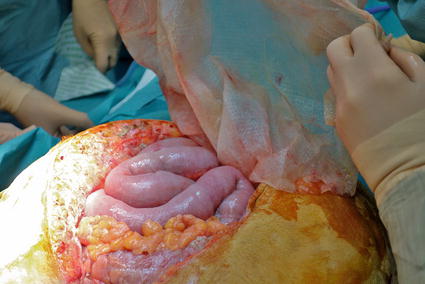Fig. 18.1
Open abdomen after 10 days of treatment with low pressure NPWT. Bowel loops looks vital and healthy and free of adhesions

Fig. 18.2
Free bowel loops after 16 days of controlled NPWT with CNP drainage film at −60 mmHg
Excessive prolonged employment of the negative–pressure system can cause intestinal loops and anastomosis desiccation, furthermore mesenteric retraction. Therefore, it is useful to vary the pressure level according to the clinical stage, to reduce the anastomosis exposition, and to carry out a peritoneal exclusion as soon as possible, humidifying the peritoneal loops. All this is possible associating to negative pressure a peritoneal washing with infusion by drainage and regulating the equipment introducing up to 200 mL of normal saline during the 15′ aspiration stop. This technique may be carried out during all the clinical stages even with peritoneal exclusion.
During intensive care and SIRS, within the first 4 days, there is intestinal edema, parietal tension and liquid loss, therefore surgery is limited to the Damage Control Surgery. During the first two medications it is possible to close the fascia.
If it is not possible to close the wound in the first 5 days, there will be a second possibility between the fifth and tenth day, when the edema decreases it is possible to have a primary or step by step fascia closure, and at a later stage a skin closure [8]. The wound closing should be carried out as soon as possible, even with an abdomen perfusion pressure at 60 mmHg and without a complete edema resolution, because a fistula risk increase after the eighth day.
If clinical conditions need to keep the abdomen open any longer, to the negative pressure with/or without washing peritoneal exclusion has to be associated. At this stage a progressive abdominal wall healing and retraction is determined with adherence development, visceral fusion up to a condition of frozen abdomen.
In this clinical conditions a “bridge closure” should be carried out using a biological mesh. We prefer to adopt a full-thickness mesh appropriately fixed, in consideration to the abdomen wall relaxation after edema reduction, with closely separated stitches to avoid hiatus development. The contaminated tissue management and the prevention of fluid collection is done by the negative pressure above the mesh, protected from desiccation or deterioration, using nonadherent dressing associated or not to fluid instillation. The skin closure will be progressive and may be helped by a negative-pressure system like the “Prevena™” without skin stitches.
In case of a frozen abdomen evolution, we need to cover the intestinal loops with skin grafts.
The fistula represents the major complication risk for mortality and morbidity, determined by the abdomen wall decay and bulging or occlusion by intestinal circular adhesions. The management becomes very difficult because is impossible to extract the intestinal loops in a frozen abdomen. In this case it is possible to cover the fistula with skin grafts or to insert a suction VAC system [9].
Prevention of abdominal hypertension and early management with open abdomen allowed Cheatham to perform a faster wound closure, from 20 to 10 days in 5 years, a major incidence of fascia primary closure, from 59 to 81 % and a minor fistula incidence from 8.6 to 3.6 % [10].
In the last decade we passed from the comprehension of the abdominal hypertension mechanisms to a prevention with an intensive care management aimed to therapeutical targets and temporary abdomen closure in at risk patients. The open abdomen management requires to use with flexibility the available techniques in a complex environment in order to save the intestinal function, carry out revisions in a short period and closing or excluding the peritoneum as soon as possible. The message is “open soon and close soon!”
Stay updated, free articles. Join our Telegram channel

Full access? Get Clinical Tree


